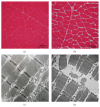How Muscle Structure and Composition Influence Meat and Flesh Quality
- PMID: 27022618
- PMCID: PMC4789028
- DOI: 10.1155/2016/3182746
How Muscle Structure and Composition Influence Meat and Flesh Quality
Abstract
Skeletal muscle consists of several tissues, such as muscle fibers and connective and adipose tissues. This review aims to describe the features of these various muscle components and their relationships with the technological, nutritional, and sensory properties of meat/flesh from different livestock and fish species. Thus, the contractile and metabolic types, size and number of muscle fibers, the content, composition and distribution of the connective tissue, and the content and lipid composition of intramuscular fat play a role in the determination of meat/flesh appearance, color, tenderness, juiciness, flavor, and technological value. Interestingly, the biochemical and structural characteristics of muscle fibers, intramuscular connective tissue, and intramuscular fat appear to play independent role, which suggests that the properties of these various muscle components can be independently modulated by genetics or environmental factors to achieve production efficiency and improve meat/flesh quality.
Figures







References
-
- Picard B., Lefevre F., Lebret B. Meat and fish flesh quality improvement with proteomic applications. Animal Frontiers. 2012;2(4):18–25. doi: 10.2527/af.2012-0058. - DOI
-
- Astruc T. Connective tissue: structure, function and influence on meat quality. In: Dikeman C. D. M., editor. Encyclopedia of Meat Science. 2nd. Oxford, UK: Elsevier; 2014. pp. 321–328.
-
- Astruc T. Carcass, composition, muscle structure, and contraction. In: Dikeman C. D. M., editor. Encyclopedia of Meat Sciences. 2nd. Oxford, UK: Elsevier; 2014. pp. 148–166.
Publication types
MeSH terms
LinkOut - more resources
Full Text Sources
Other Literature Sources

